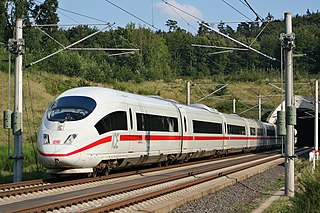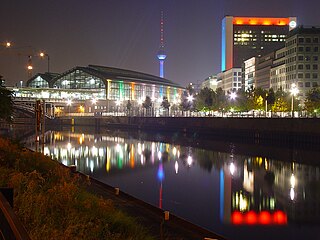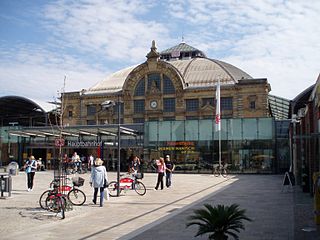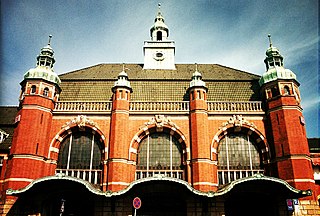Related Research Articles

Intercity Express is a high-speed rail system in Germany. It also serves destinations in Austria, France, Belgium, Switzerland and the Netherlands as part of cross-border services. It is the flagship of the German state railway, Deutsche Bahn. ICE fares are fixed for station-to-station connections, on the grounds that the trains have a higher level of comfort. Travelling at speeds up to 320 km/h (200 mph), they are aimed at business travellers and long-distance commuters and marketed by Deutsche Bahn as an alternative to flights.

The Berlin S-Bahn is a rapid transit railway system in and around Berlin, the capital city of Germany. It has been in operation under this name since December 1930, having been previously called the special tariff area Berliner Stadt-, Ring- und Vorortbahnen. It complements the Berlin U-Bahn and is the link to many outer-Berlin areas, such as Berlin Brandenburg Airport. As such, the Berlin S-Bahn blends elements of a commuter rail service and a rapid transit system.

Frankfurt (Main) Hauptbahnhof, also called Frankfurt Central Station and Frankfurt Main Station, is the busiest train station in the German state of Hesse. Due to its location near the middle of Germany and usage as a transport hub for long and short distance travelling, Deutsche Bahn refers to it as the most important station in Germany.

Hamburg Hauptbahnhof, or Hamburg Central Railway Station in English, is the main railway station of the city of Hamburg, Germany. Opened in 1906 to replace four separate terminal stations, today Hamburg Hauptbahnhof is operated by DB Station&Service AG. With an average of 550,000 passengers a day, it is Germany's busiest railway station and the second-busiest in Europe after the Gare du Nord in Paris. It is classed by Deutsche Bahn as a category 1 railway station.

Stuttgart Hauptbahnhof is the primary railway station in the city of Stuttgart, the state capital of Baden-Württemberg, in southwestern Germany. It is the largest regional and long-distance railway station in Stuttgart, the main node of the Stuttgart S-Bahn network, and, together with the station at Charlottenplatz, it is the main node of the Stuttgart Stadtbahn.

Mainz Hauptbahnhof is a railway station for the city of Mainz in the German state of Rhineland-Palatinate. It is used by about 60,000 travelers and visitors each day and is therefore by far the busiest station in Rhineland-Palatinate. The station was a trial area for a CCTV scheme using automated face recognition.

Chemnitz Hauptbahnhof is the main railway station in Chemnitz in Germany.

The Rhine-Main S-Bahn system is an integrated rapid transit and commuter train system for the Frankfurt/Rhine-Main region, which includes the cities Frankfurt am Main, Wiesbaden, Mainz, Offenbach am Main, Hanau and Darmstadt. The network comprises nine S-Bahn lines, eight of which currently travel through the cornerstone of the system, a tunnel through central Frankfurt. The first section of this tunnel was opened on May 28, 1978. Further tunnel sections were opened in 1983 and 1990, before its completion in 1992. The system belongs to the Rhein-Main-Verkehrsverbund (RMV) and is operated by DB Regio, a subsidiary of Deutsche Bahn.

Mannheim Hauptbahnhof is a railway station in Mannheim in the German state of Baden-Württemberg. It is the second largest traffic hub in southwestern Germany behind Stuttgart Hauptbahnhof, with 658 trains a day, including 238 long-distance trains. It is also a key station in the Rhine-Neckar S-Bahn. 100,000 passengers embark, disembark or transfer between trains at the station each day. The station was modernised in 2001. It is classified by Deutsche Bahn as a category 2 station.
The Main Railway is a 37.5 km-long double-track electrified railway line, which runs on the south side of the river Main from Mainz to Frankfurt central station.

Ingolstadt Hauptbahnhof is a railway station in the Bavarian city of Ingolstadt, situated in southern Germany. Ingolstadt station is an important junction in the Deutsche Bahn network. It has 7 platform tracks and is classified by Deutsche Bahn as a category 2 station.

Oberhausen Hauptbahnhof is a railway station in Oberhausen, North Rhine-Westphalia, Germany. The station was opened in 1847 and is located on the Duisburg–Dortmund railway, Arnhem-Oberhausen railway, Oberhausen–Duisburg-Ruhrort railway and Oberhausen-Mülheim-Styrum railway and is served by ICE, IC, RE and RB services operated by Deutsche Bahn, Abellio Deutschland, NordWestBahn and Eurobahn.

Railjet is a high-speed rail service in Europe operated by Austrian Federal Railways (ÖBB) and Czech Railways (ČD). Branded as Railjet Express (RJX) for the fastest services and as Railjet (RJ) for services with additional stops, it was introduced in 2008 and operates at speeds of up to 230 km/h (143 mph). Railjet is ÖBB's premier service and operates both domestically within Austria and on international services to adjacent major cities in the Czech Republic, Germany, Switzerland, Italy, Hungary and Slovakia.

Halle (Saale) Hauptbahnhof is the main railway station in the city of Halle (Saale) in southern part of the German state of Saxony-Anhalt. The station is situated east of the city centre and is a category 2 station.

The Stuttgart–Horb railway is a 67.227 kilometer-long railway in the southern part of the state of Baden-Württemberg in Germany, running from Stuttgart to Horb. It forms part of a railway known as the Gäubahn or Gäu Railway. The Royal Württemberg State Railways and the Baden State Railways constructed the majority of this line between the years 1866 and 1879. Today the partially single-track, fully electrified line features the high-speed Intercity-Express (ICE) service, with its tilting train technology, traveling from Stuttgart to Zürich. In addition, a multitude of local train services of numerous railway companies are on offer. The Gäu Railway is also a significant line in the North-South freight service system.

Lübeck Hauptbahnhof is the main railway station serving the Hanseatic city of Lübeck, in the German state of Schleswig-Holstein. It is a through station at the western edge of the city centre. With around 31,000 travelers and visitors each day, Lübeck Hbf is the busiest of all the railway stations in Schleswig-Holstein. It is classified by the Deutsche Bahn as a category 2 station.

The Ruhr–Sieg railway is a 106 km long double-track, electrified main line from Hagen to Siegen via Iserlohn-Letmathe, Finnentrop and Kreuztal in the German state of North Rhine-Westphalia. The line, which has many tunnels, runs primarily through the valley of the Lenne. South of Altenhundem it crosses the watershed between the Lenne and the Sieg. The line was opened between 1859 and 1861 and is one of the oldest railways in Germany.

Tübingen Hauptbahnhof is the largest station in the university town of Tübingen and the district of Tübingen, and a transport hub in the German state of Baden-Württemberg.

The Rostock S-Bahn is a S-Bahn network in Rostock in the German state of Mecklenburg-Vorpommern. It consists of three lines with a total length of about 90 km. Line S1 runs from Rostock Hauptbahnhof to Warnemünde within the Rostock urban area. S-Bahn operations started on 28 September 1974. Later, the lines to the north-east to the port (Seehafen) of Rostock and to the south to the town of Güstrow via Schwaan were included in the S-Bahn network. The line to the port was discontinued in 2012, but at same time the line to Güstrow via Laage was included as line S3 of the S-Bahn. Until 2014 the rolling stock mainly consisted of push–pull trains with Waggonbau Görlitz double-deck coaches. Since then all lines have been operated with new Bombardier Talent 2 railcars.
References
- ↑ "Die Wege am Hauptbahnhof werden länger" [The ways at the main station become longer.] (in German). Stuttgarter Nachrichten. May 27, 2013. Retrieved April 4, 2017.
- 1 2 3 4 5 6 7 8 9 10 11 12 13 14 15 16 17 "Untersuchungsbericht Zugentgleisung Stuttgart Hbf" [Investigation Report Train Derailment Stuttgart Main Station] (in German). EUB. April 8, 2014. Archived from the original on April 4, 2017. Retrieved April 4, 2017.
- ↑ "IC entgleist in Stuttgart – Passagiere eingesperrt" [IC derailed – passengers trapped] (in German). Die Welt. September 29, 2012. Retrieved April 6, 2017.
- ↑ "Schon wieder IC-Zug am Bahnhof entgleist" [Again an IC train derails at station] (in German). Stuttgarter Zeitung. October 9, 2012. Retrieved April 6, 2017.